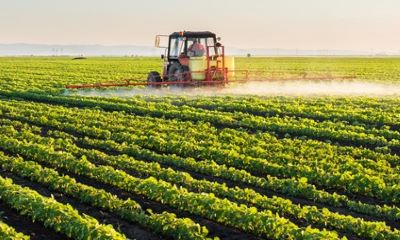Indian Chemical News (ICN) shares an overview on the growth potential of Indian agrochemical sector

The current global agrochemicals market size is estimated at US $43 billion and is predicted to grow to US $96.32 billion by 2028 at an average annual growth rate (AAGR) of 4%. The Indian share stands at around US $7.9 billion and we are growing at a rate of 9.8%. This was stated by Pravin Prashant, Executive Editor, Indian Chemical News (ICN) while sharing an overview on the Indian agrochemical sector at the AgroChem Summit 2023 held in New Delhi on December 15, 2023.
“We are the 4th largest producer globally after the USA, China and Japan. We are second largest in exports which is about 5.5 billion at a sustainable growth rate (SGR) of 13%. We are looking at a forecast of 12.58% with the SGR of 9.75%, thereby contributing to the Indian economy in a very big way. And in terms of exports, we definitely seem to move faster in this because of the lot of capacity expansions being planned by the industry,” added Prashant.
In terms of agriculture industry performance, Prashant pointed out the data of FY 2022-23 which suggests 18.3% growth rate. “We have added 40 million tonnes, so it is around 329.7 million tonnes. And the best part about it is that we have growth in all the sectors, whether it is rice, wheat, cereals, pulses, oilseeds, sugar or cotton. The growth that we are showcasing here in terms of food production is at 4.43%. In horticulture, we are higher which is 351.9 million tonnes and we have grown in all the categories, whether it is food production, vegetable production, potato production or plantation crops.”
Talking about the support from the government, Prashant said, “There are many good initiatives by the government including providing Rs 1261 crore for drones, supporting 15,000 women self-help groups. It will assist in 80% cost, up to a maximum of eight lakh in the nano-fertilizer and pesticide formulation. The rest balance would be through the National Agriculture Infrastructure Financing Facility. There are technologies in agriculture that will definitely improve efficiency and answer crop yield and reduce cost of operation for the benefit of the farmers. The real challenge is that if we are somehow achieving around 9.5% to 9.75%, we can try reaching 12% growth. We are talking about massive capacity building because of China plus one and Europe plus one. We require new plants and R&D facilities with lot of sustainable products to meet the global demand.”
Stressing on easing out the bottlenecks for innovation, Prashant called for better coordination between stakeholders. “Respective organizations are moving forward faster with registration of new molecules. This is one area which needs to be taken forward at a mission mode by the government. I think the industry will definitely support it but safeguarding IP data protection laws must be taken care of. The time bound environment clearances are a must if we are looking at higher growth. Decriminalizing laws such as Maharashtra Prevention of Dangerous Activities (MPDA) Act of Slumlords, Bootleggers, Drug Offenders and Dangerous Persons and Video Pirates, or Act of 1981. To prevent these from acting as obstacles, the ecosystem must work in synergy and the goal should be that government, industry, academia works together.”
On the growing role of biologicals, Prashant added: “Global biologicals market is evolving and is expected to be US $19.3 billion by 2030. The biologicals that we have taken into account are biocontrol, bio-nutrition and bio-stimulant. The highest contribution will be coming from biocontrol, second highest from bio-stimulant at the third highest from bio nutrition. The global biologicals market will be driven by integration with technologies, synthetic crop protection a fertilizer products and automation coming into picture. This will be enabled by precision applications, digital solutions and data analytics. Regulatory pressures and consumer preference creating favourable scenarios for biological roles. Indian agrochemical players should also focus on biologicals and see how they can enhance their revenue order portfolio.”
Subscribe to our newsletter & stay updated.